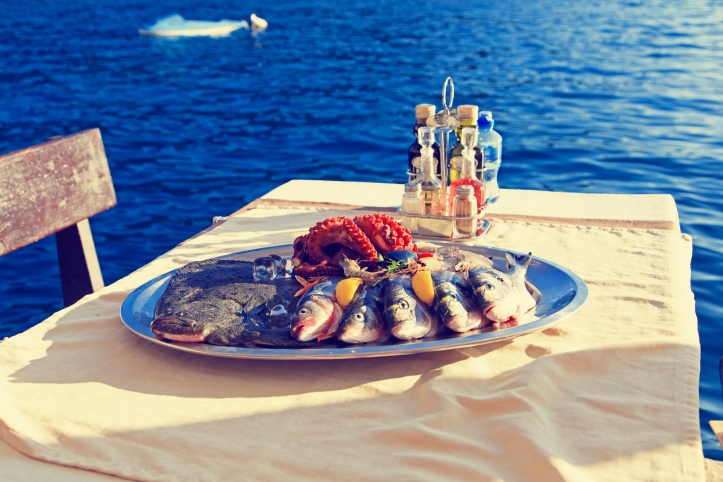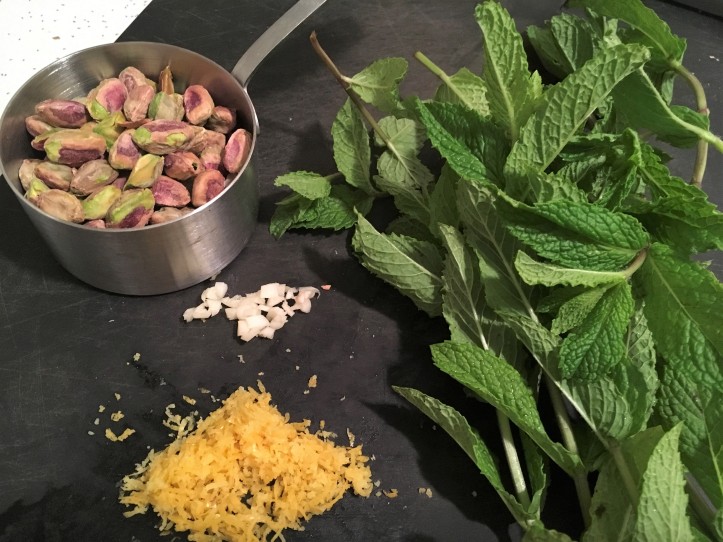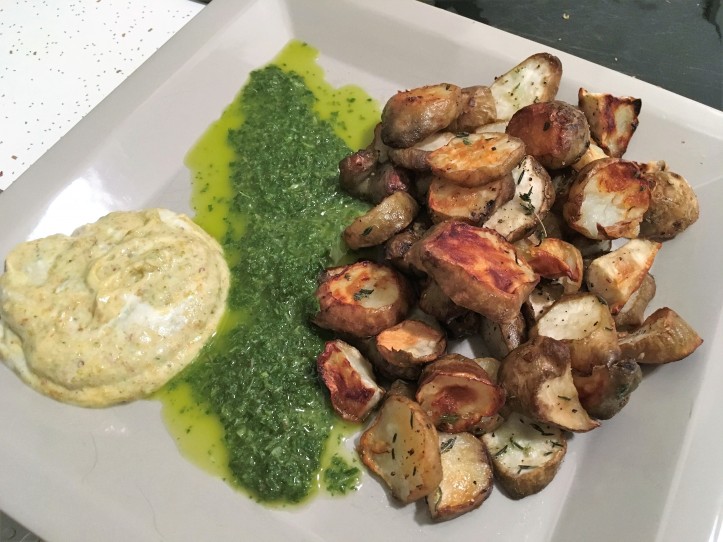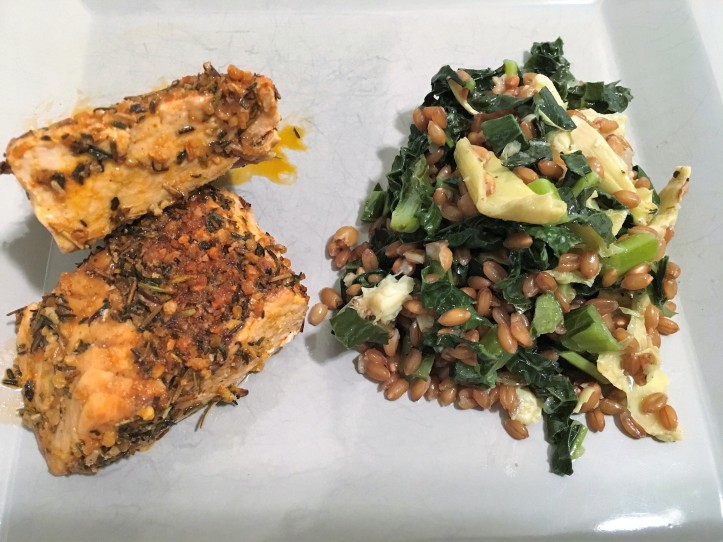Spring weather has finally arrived in the northeast – with summer’s heat and humidity already nipping at her heels. When the first week of May is warmer in New York than it is in South Florida, something’s up. I’ll try not to complain, though, as I’m happy to bid adieu to the chilly, rainy days that have dampened our enthusiasm for weeks.
The Italian Food Wine & Travel group (#ItalianFWT) has energy to spare this month, as we follow Susannah from Avvinare on a quest to understand Vermentino. You can read her great intro to the grape here. Found in Liguria, Sardinia, Tuscany, and a few other pockets of Italy, this grape makes crisp, white wines that are perfect for summer. Close your eyes, adopt your best Italian accent, and just say it: Ver-Men-TEE-Noh. Don’t you feel better already?

When I think of Vermentino, I imagine lingering at a sun-dappled table, supping on fresh seafood and sipping a cool glass of lemony goodness. Doesn’t it sound like the perfect Saturday morning escape? We’d love for you to join us as we share what we’ve learned about the grape, the wines we’ve tasted, and what we’ve paired with them. We start Saturday morning, May 5th at 11 am ET on Twitter, following the hashtag #ItalianFWT. It’s always a great way to kick off the weekend.
Curious about Vermentino? Here’s what the gang will be talking about on Saturday:
Gwen from Wine Predator is sharing “You Need To Know Vermentino: Paired with Carbonara #ItalianFWT.”
Jill from L’Occasion is adding “Vermentino from Maremma, Land of The Butteri Tuscan Cowboys.”
Jane from Always Ravenous is penning “Which Vermentino to Pair With Shrimp & Fresh Herb Pilaf?”
Lynn from Savor the Harvest is contributing “One Italian Island White Wine You Must Try.”
Katarina from Grapevine Adventures is dishing on “Vermentino by Antonella Corda – An expression of Sardinia Terroir.”
David from Cookingchatfood is giving us “Salmon with Lemon Olive Relish and a Vermentino.”
Jennifer from Vino Travels Italy is reflecting on “Vermentino of Toscana with Aia Vecchia.”
Nicole Ruiz Hudson from Sommstable is bringing “Piero Mancini Vermentino and Salmon Two Ways.”
Camilla Mann from Culinary Adventures with Cam is posting “From Sardegna to the Land Down Under: Vermentino + Pizza alle Vongole.”
Wendy from A Day In The Life on The Farm gives us “A Successful Search for Vermentino.”
Susannah from Avvinare, is all about “Vermentino in its Varied Styles from Liguria to Sardegna.”
Here at The Swirling Dervish we’re doing “Vegetarian Plates and Pigato from A.A. Durin: Perfect for Your Summer Table.”
This Is an A.P.B. – Be on the Lookout for Vermentino (Known Aliases: Pigato, Favorita, Rolle). Warning: Suspect Is Considered Disarming and Delicious.
More than 50 different wines from Vermentino are made in Italy. In fact, it plays the starring role in one DOCG (Sardinia) and 22 DOCs (11 in Tuscany; 6 in Liguria; 3 in Sardinia; and one each in Piemonte and Umbria. And that doesn’t account for the oceans of table wine served by the carafe to hordes of thirsty tourists. Has Vermentino always been so prominent?
After many years of examination and argument, wine scholars have concluded that the grapes known as Favorita in Piemonte, Pigato in Liguria, and Rolle in Corsica (Sardinia’s neighbor to the north) are all Vermentino. While there is quite a bit produced in Liguria, Vermentino is perhaps most closely associated with the island of Sardinia. No surprise, really, given that the grape takes well to poor soils, especially in hot, dry climates. It thrives in the salty, windy environment near the sea.

Vermentino di Gallura, produced in the northern tip of Sardinia, is the island’s sole DOCG, and makes a richer, more full-bodied style of wine redolent of tropical fruit. Winemakers here have experimented with resting the wine on its lees and barrel aging to produce that richer style. It makes a nice contrast with the lighter, more citrusy versions that are more familiar. All of the wines finish with a decidedly mineral, saline flavor, showing off their seaside roots.
It’s interesting to note that the Bolgheri region, on the Tuscan coast, also makes wines from Vermentino. Famous for its Super Tuscan red wines, Bolgheri DOC permits Vermentino in its white blends, where it comprises no more than 70% of the mix, and also in its varietal wines, where it must be at least 85% of the blend.

Azienda Agricola Durin
The first vineyards at Durin were established in 1939 by Isidoro Basso, who started with just under ten acres of land. Over the years, subsequent generations of the family added small patches to the total, and that’s how it looks today: 230 tiny parcels of vineyards spread out over 40 acres. Each spot must be tended manually, thanks to the steep terraces, and the plots are not all contiguous –olive groves, mountain streams, and rocky outcroppings make traveling between the vineyards tough work.
As one might expect from so many different sites, elevations, aspects, and soils vary too. Some of the vines are planted at 150 feet above sea level; others significantly higher at 1,400 feet. In some places the soils are rich and dark, showing their iron and clay content, while in others the earth is white clay and sand (the famous terra bianca). All of the vines benefit from cool mountain breezes blowing down from the north, as well as the moderating influence of the sea, a mere three miles away.
Vineyards are farmed sustainably, an effort made a bit easier by the cool breezes, and harvest is always by hand, a condition mandated by the steep vineyard slopes and the scatter-shot location of the different parcels. Third-generation winemaker Antonio Basso takes a gentle approach in the cellar, keeping grapes cool during fermentation, using only indigenous yeasts, and allowing the white wines to age on fine lees for enhanced texture.

My First Taste of A.A. Durin Riviera Liguria di Ponente Pigato
Last month, my husband and I went exploring in New York City, where we first met. As we searched for a place to eat early on a Saturday night, we happened upon one of our old favorite places (Five Points) which had been relaunched by the original owners as Vic’s. Our dinner was one of the best meals I’ve had in the city in a long time. The vibe is casual but the food is serious. You can read more about it in my recent post.

One of the things I loved about Vic’s was the wine program. The list is small but well-chosen, and offers an array of really interesting choices, all available by the glass, quartino, or bottle. My first glass was this Pigato, and it definitely didn’t disappoint! Brilliant with both of our small starter plates (sunchokes; herbed clams) this wine was refreshing – full of citrus flavors, a hint of peach and honey, and a fragrant note of basil, concluding with a long finish redolent of white pepper and almond. Tons of acidity and a rounded mouthfeel made this the perfect accompaniment to the vegetables and the shellfish.
My Pairings
#1: Reverse-Engineering a Recipe
The sunchoke dish we had at Vic’s was a revelation – it’s truly one of the most creative and delicious dishes I’ve tried. The chokes were sliced thin and roasted, then composed on the plate with a pistachio and lemon-zest yogurt and a fragrant fresh mint oil. I decided to try and recreate it at home.

I’d never cooked sunchokes before, but was curious about them. Here’s what I learned: at just under a dollar a pound, they are a budget-minded cook’s dream. They’re also super-easy to make; I sliced and roasted them with some olive oil and salt and pepper at 350 for about 30 minutes.
I looked online for recipes for pistachio yogurt sauce, and here’s what I found from Bon Appétit. It was very good, although not as finely textured as the one at Vic’s. As for the mint oil, that was going to take too much time and I didn’t have a coffee filter or strainer, so I opted for mint pesto instead. Just one small garlic clove and some olive oil in the food processor with the mint; no nuts or cheese. My version was thicker but much quicker – and it tasted great!
As with the Vic’s professional version, my streamlined version made a delicious match with the Pigato. I will absolutely make this again – and serve it with this wine!

#2: Too Tired to Cook
The following night I realized I had no energy to spend time in the kitchen – not even to grill a chicken breast. It happens once in a while, usually when my To-Do list infringes on my free time. But I was prepared! My last grocery order had included a prepared Farro Salad with Artichokes and Kale in a Citrus Vinaigrette and Lemon Dill Salmon. I pulled a plate from the shelf and voilà! It looked pretty, tasted great, and cost me no stress or time. And the wine? Beautiful! It brought out the sweetness of the farro, while the kale seemed to highlight the florally-citrus notes in the wine. The salmon worked well, too, bringing out the slightly herbal character of the Pigato. I was sorry to pour the last few drops into my glass. Note: For vegetarians, the farro salad makes a filling and satisfying meal on its own. A couple of nights later, I enjoyed it solo, after a super-long day.


2015 Azienda Agricola Durin Riviera Liguria di Ponente Pigato (13% abv; about $20 retail)
100% Pigato from 50-year-old vines. Soils are sandy limestone, which contribute a racy, mineral edge to the wine. Grapes were hand-harvested, then fermented and aged in temperature-controlled stainless steel tanks and aged on the fine lees.
About the Italian Food Wine & Travel Group
We’re a bunch of food- and wine-loving bloggers who meet virtually on the first Saturday of each month to discuss a particular theme of interest. Each of us writes a post on the topic, which goes up just prior to our live chat on Twitter at 11 am ET. If you’d like to follow the conversation, you’re welcome to join us. Next month our theme is Soave, another perfect-for-summer white wine, with our host Li of The Wining Hour.
[…] Lauren from The Swirling Dervish is writing “Vegetarian Plates and Pigato from A.A. Durin: Perfect for Your Summer Table” […]
LikeLike
Hah….we had our one day of Spring here in Michigan and now are into full blown summer. We went from freezing to one day of 60 degrees and then a week of 80 degree weather. I love sunchokes and your recipe sounds amazing. Thanks for sharing.
LikeLiked by 1 person
Thanks Wendy! Glad I’m not the only one. This was the first time I’ve made sunchokes, and I will definitely make them again. Easy and delicious – right up my alley!
LikeLike
Great journey through the Italian regions that produce Vermentino! I like the sound of the sunchoke, sounds like I need to try cooking them soon too.
LikeLiked by 1 person
Thanks David. The sunchokes were delicious and very easy to make. Let me know if you decide to experiment with them!
LikeLike
[…] Lauren from The Swirling Dervish is writing “Vegetarian Plates and Pigato from A.A. Durin: Perfect for Your Summer Table” […]
LikeLike
Deliciously written Lauren! 🙂 Even in NYC, I’m impressed a restaurant has Pigato by the glass! Think I’ve only had one of these in my life.
LikeLiked by 1 person
Thanks! It was a real surprise to see so many off-the-beaten-path wines on a BTG menu. Love it!
LikeLike
Think I told you after reading about your stumbling on Vic’s that the sunchoke dish with its combo of flavors looked amazing. Your recreation looks the same, especially like the mint pesto versus oil. I know what I’m making with the sunchokes I just bought! I’ve not tasted vermentino from Liguria, my interest is piqued.
LikeLiked by 1 person
Ooh! Let me know how they turn out. I’ll have to make another batch soon, too.
LikeLike
Love that you picked one from Liguria and your choices on the dishes. Props to you for trying to recreate the dish you had. Loved some of your facts about this grape I didn’t know.
LikeLiked by 1 person
Thanks Jennifer. Yes, this month was an experimental one in the kitchen!
LikeLike
I love how you recreated that tasty sunchoke dish. The mint pesto was a brilliant idea.
LikeLiked by 1 person
Thank you! The restaurant version was clearly superior to mine, but I had a lot of fun playing in the kitchen. And it tasted pretty good!
LikeLike
Looks delicious. Love Vermentino! ….and Liguria!
LikeLiked by 1 person
Thanks! It was fun exploring this grape.
LikeLike
Such a beautifully complete exploration of the variety and her food friends!
This reads like a lovely book – I really enjoyed this post. Good thing I’m about to eat because now I’m craving something delicious!
LikeLiked by 1 person
Thanks Jill. This was a fun topic, and I discovered my new favorite ingredient: sunchokes!
LikeLiked by 1 person
I need to work with those soon!
LikeLiked by 1 person
Great post, Lauren. Funny thing: I have only ever eaten sunchokes raw. I will have to try to roast them.
LikeLike
Great article Lauren, I love Vermintino. The food pairings look great! Clever you for using the faro salad. It all looked delish!
LikeLiked by 1 person
Thanks Amber! This was a fun topic, with so many possible directions to take. I really enjoyed reading all the posts – I learned a lot about Italy and Vermentino, and got plenty of inspiration for the kitchen!
LikeLike
Those dishes sound great with Vermentino! So much information in your post Lauren! And next time I have extra mint, I’m making mint pesto!
LikeLiked by 1 person
Thank you! I look forward to reading all about it. Mint should be popping up everywhere soon; enjoy it!
LikeLike
Thanks so much! It was a lot of fun reverse-engineering the restaurant dish: and it came out pretty well. Summer’s on the way, so mint will be taking over unsuspecting garden plots everywhere – enjoy it!
LikeLike
Nice to learn something new 🙂 I have never had the wine from this particular winery and did not really know them before either. Such delicious looking food, I am sure the pairing was fab.
LikeLiked by 1 person
Thanks Katarina! This month’s event was a lot of fun – good food and good wine. What’s better than that?
LikeLike